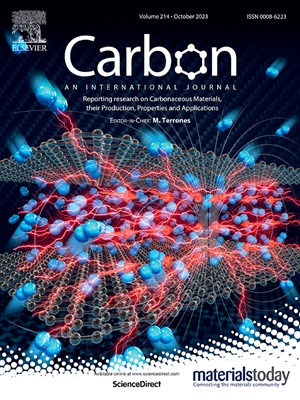探索石墨二炔--通过 ReaxFF-MD 和实验对表面氧化机制进行动态表征
IF 10.5
2区 材料科学
Q1 CHEMISTRY, PHYSICAL
引用次数: 0
摘要
本文章由计算机程序翻译,如有差异,请以英文原文为准。
Exploring graphdiyne - Dynamic characterisation of the surface oxidation mechanisms via ReaxFF-MD and experiments
Graphdiyne (GDY) is an emerging two-dimensional carbon allotrope comprising unique sp1 and sp2 hybridisation, which has attracted extensive investigation into various applications, especially as battery component materials owing to its excellent electromechanical properties. However, GDY's thermal stability and oxidation behaviour have yet to be evaluated, which is crucial to safety in high-energy applications. The present study characterised the thermophysical properties of GDY via reactive molecular dynamics (MD-ReaxFF) and experimental measurement. The oxidation kinetics and decomposition behaviour were elucidated and benchmarked with graphene (GP) and graphyne (GY) to investigate the correlation between thermal stability and morphology of carbon nanomaterials. The simulation results revealed the initial oxidation mechanism of GDY sheets, where the cleavage of C–C bonds was observed at the acetylenic chain and could be identified as the weak spots of the structural stability. As for oxidation kinetics, GDY's experimental and numerical activation energy was found to be 173.1 and 133 kJ/mol, which is lower than 220.8 kJ/mol of GP. The current work pioneer investigated the thermal stability of GDY using both experimental and numerical approaches. Meanwhile, different oxidation mechanisms between GP and GDY were distinguished and demonstrated in detail.
求助全文
通过发布文献求助,成功后即可免费获取论文全文。
去求助
来源期刊

Carbon
工程技术-材料科学:综合
CiteScore
20.80
自引率
7.30%
发文量
0
审稿时长
23 days
期刊介绍:
The journal Carbon is an international multidisciplinary forum for communicating scientific advances in the field of carbon materials. It reports new findings related to the formation, structure, properties, behaviors, and technological applications of carbons. Carbons are a broad class of ordered or disordered solid phases composed primarily of elemental carbon, including but not limited to carbon black, carbon fibers and filaments, carbon nanotubes, diamond and diamond-like carbon, fullerenes, glassy carbon, graphite, graphene, graphene-oxide, porous carbons, pyrolytic carbon, and other sp2 and non-sp2 hybridized carbon systems. Carbon is the companion title to the open access journal Carbon Trends. Relevant application areas for carbon materials include biology and medicine, catalysis, electronic, optoelectronic, spintronic, high-frequency, and photonic devices, energy storage and conversion systems, environmental applications and water treatment, smart materials and systems, and structural and thermal applications.
 求助内容:
求助内容: 应助结果提醒方式:
应助结果提醒方式:


